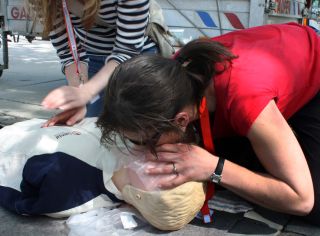Environment
What Stops People from Helping During Crises?
A new study offers insights for motivating people to assist others in need.
Posted March 17, 2024 Reviewed by Hara Estroff Marano
Key points
- A new scientific paper reviews knowledge on what stops people helping others during a crisis.
- The key inhibitors cluster around not wanting to assist and not being able to assist.
- Bringing in more baseline science might reveal deeper insights into unwilling-to-help mindsets.
You witness a multi-vehicle collision as you amble along the street, or your immunocompromised neighbour asks you to shop for them as a new virus spreads. Would you help? Uninjured after an earthquake, do you dig through the rubble or flee as far as possible from collapsed structures? Following a bomb, would you consider emptying the shelves of first-aid supplies to treat the wounded?
The psychology of willingness to help has been long studied. We remain a long way from fully understanding human responses. How much accuracy and precision remains in the crisis-response categories of the four f’s: flight, fight, freeze, and friend? Are we ever truly altruistic, or do we help others merely to help ourselves? Does declining to render safe assistance necessarily convey selfishness and self-absorption? How much do we value our life over a stranger’s?
A new review paper
A research team across psychology, philosophy, and law summarised many aspects of unwillingness to help during a crisis. Led by Małgorzata Kossowska at Jagiellonian University in Kraków, Poland, they reviewed published science on factors stopping individuals from assisting others. They reported their findings a few weeks ago in the Journal of Community & Applied Social Psychology.
The group searched for material over an impressive time frame, from 1945 to 2021, using lucid definitions to define their scope, as framed by motivational readiness theory. Their initial search identified 12,071 possibly relevant scientific pieces. After screening for relevance to their mandate, they ended up reviewing in detail 61 papers. They categorised the methods used by these studies as quantitative, qualitative, quantitative and qualitative, theoretical, meta-analysis, and simulation. Barriers were considered to be individual, group/community, institutional, and societal.

The authors clustered barriers into two broad categories. First, “the desire to help”, so there must be individual interest and willingness to assist. This was impeded mostly by worldview, ideology, and feelings toward the people being helped. Second, “help attainability”, so there must be ability to assist. This was hindered mainly by structures and organizations not offering support. The support might be preparedness, protocols, training, skills, equipment, coordination, or resources. Perceptions of risks and uncertainties were part of the equation, with ignorance or perceived ignorance influencing decisions alongside misapprehensions and myths.
Overall, as expected, it is complicated. Multiple factors interact in multiple ways across multiple individual and collective norms and expectations, following multiple trajectories for multiple reasons leading to the same outcome of not helping.
Building on the paper’s research
The study could perhaps have delved more fully into the vast science available in order to deepen the analysis. Part of understanding why people do not help in times of need might be linked to terminology removing responsibility from society.
Disaster research proffers decades-long objections to the term “natural disaster”, since disasters occur due to where and how people are forced to live, rather than from nature’s phenomena, such as earthquakes and hurricanes. Instead of some being natural, some being human-made, and some being hybrid, they are all disasters from similar baseline causes.
“Accident” is queried on the same premise. Society knows how to prevent and prepare. If resources are allocated otherwise, is it really an accident?
“Migration crisis” formulates migration and migrants as highly problematic. Is the crisis really that so many people risk their lives for the dream of circumstances that many of us take for granted? Or that they use their life savings and accrue debt to pay smugglers who ignore basic safety? Or is the crisis that economic, political, and resource structures compel people to feel forced to leave their homes, cultures, and families, while these same structures tacitly support these people’s exploitation?
How inhibiting are these phrases? We do not know, because as Kossowska and colleagues show, no one has looked at this specific topic, yet so many authors continue to use the terms without critique. There is so much science on the problems with these terms used uncritically while offering alternatives. There is also so much science on helping or not helping others. We lack investigations that combine the two.
We need further work on any changes over time to gawking and rubbernecking. Kossowska and colleagues rightly cite and critique a 1957 piece on “convergence behavior” in disasters. Some people converge toward disaster sites to help, out of concern for people they know, and for voyeurism. Has the advent of phones with video recording, influencers seeking clickbait, and “rescuetainment” (coined by Nancy Rigg to cover entertainment about rescues) changed the viewer-to-helper ratio? Or is it just more of the same in different ways? Have pranksters creating or pretending to create crises influenced people’s interest in assisting?
Have our attitudes changed regarding being hurt or putting ourselves at risk, possibly supported by physical distancing being more engrained due to the COVID-19 pandemic from 2020-2023? “Physical distancing” is the preferred phrase over “social distancing”, since the core idea was to retain social connections while being physically apart.
Certainly, COVID-19 responses continued the trend of mental health support being much more prominent than it was in 1957. Assisting during crises via mental health also provides different ways of helping, without fear of encountering someone else’s blood or microbes, although the helper experiences other risks.
So “Socio-psychological barriers preventing people from helping in times of crisis”, as per the paper’s title, tells us so much about ourselves and how to improve. Especially when considering, even more, socio-psychological enablers.
References
Kossowska, M., P. Szwed, A. Czernatowicz-Kukuczka, J. Perek-Białas, E. Szumowska, A.W. Kruglanski, K. Gadowska, M. Kami, and W. Załuski. 2024. Socio-psychological barriers preventing people from helping in times of crisis: A scoping review. Journal of Community & Applied Social Psychology, vol. 34, no. 2, article e2775.
Fritz, C.E. and J.H. Mathewson. 1957. Convergence Behaviour in Disasters: A Problem in Social Control (Disaster Study No. 9). National Academy of Sciences, Washington, D.C.
Fritz, C.E. and H.B. Williams. 1957. The Human Being in Disasters: A Research Perspective. The Annals of the American Academy of Political and Social Science, vol. 309, pp. 42-51.
Vaux, T. 2001. The Selfish Altruist. Earthscan, London.




